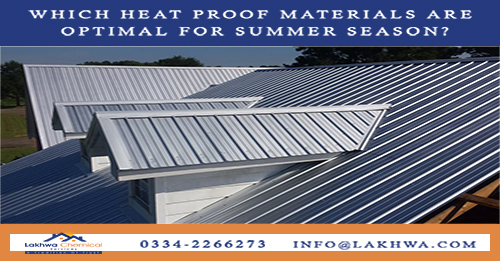Which Heat Proof Materials are Optimal for Summer Season?
The summer season brings sweltering heat and perspiring conditions within closed structures. Naturally, finding ways to keep your living space cool and comfortable becomes a top priority. Choosing heat-proof materials for your home can contribute to reducing heat absorption and maintaining a pleasant indoor environment. Here are some optimal heat-proof materials to consider for the summer season
Reflective Roofing
A significant portion of heat enters the home through the roof. Using reflective roofing materials can help minimize heat absorption. Options like metal roofs, clay or concrete tiles, or specially designed cool roof coatings have high solar reflectance, bouncing off a significant amount of sunlight and reducing heat transfer.
Insulation
Adequate insulation is crucial for regulating indoor temperatures throughout the year. Insulation materials like fiberglass, cellulose, or spray foam help prevent heat transfer, keeping your home cooler in summer. Insulating the walls, ceilings, and attic space can reduce the amount of heat that infiltrates your premises.
Read More
How to Prevent the Roof from the Sun’s Rays in Pakistan?
How to Find a Solar Roof Coating Price in Pakistan?
Heat-Reflective Window Films
Heat can also enter through windows, an open-source fixture in a structure. To restrict torrid conditions and block noxious UV rays, apply heat-reflective window films. These layers are made from polyester laminates that reflects a significant portion of the Sun’s heat and light.
Thermal Mass Materials
Utilizing thermal mass materials in your home can help regulate indoor temperatures. Materials like concrete, stone, or clay tiles have high thermal mass properties, meaning they can absorb and store heat during the day and release it slowly during cooler periods. This helps to stabilize indoor temperatures, reducing the need of excessive cooling.
Exterior Sunshades or Awnings
Installing exterior sunshades or awnings on windows and doors can block direct sunlight, reducing heat gain in closed structures. These shading devices are made from materials like fabric, aluminum, or wood; they are positioned to intercept and diffuse sunlight.
Heat-Resistant Paint
Choosing heat-resistant paint for exterior walls can help reflect sunlight and prevent heat absorption. Light-colored paints with high solar reflectance are optimal for minimizing heat ingress. These paints have high emissivity; they radiate heat and keep the surface cool.
Read More
Does Heat Proofing Comes in Construction Chemical Companies in Karachi?
Is Water and Heat Proofing in Pakistan Reasonable for the Middle Class?
Heat Proofing and Construction Chemical Companies in Pakistan
Natural or Synthetic Cool Roof Coatings
Cool roof coatings are formulated to reflect sunlight and maintain lower surface temperatures. These coatings can be applied to various roofing materials like asphalt shingles, metal roofs, or concrete tiles. They typically have high solar reflectance and thermal emittance properties, effectively reducing heat absorption.
Proper Ventilation
Implementing proper ventilation strategies can help dissipate trapped heat and improve airflow in your home. Using roof or attic vents, exhaust fans, or whole-house ventilation systems can prevent heat buildup and promote cross-ventilation, improving indoor comfort
Natural Shade Providers
Planting trees or installing pergolas, trellises, or shade sails around your home can provide natural shade and reduce heat gain through windows and roofs. Trees with broad canopies can shield your home from direct sunlight, creating a cooler microclimate.
Heat-Resistant Flooring
Choosing materials with strong heat resistance can help maintain a cool indoor environment. Options like ceramic or porcelain tiles, concrete, or natural stone have low thermal conductivity, meaning they do not readily absorb or retain heat.
It’s important to note that the effectiveness of heat-proof materials vary depending on factors, such as climate, building design, and local conditions. Consulting with professionals or experts in the field can help you choose the most suitable materials.
By incorporating heat-proof materials, you can reduce heat absorption, create a more comfortable living space, and minimize reliance on air conditioning, leading to energy savings. To find out more, contact Lakhwa Chemical Services today.









Leave a Reply
Want to join the discussion?Feel free to contribute!